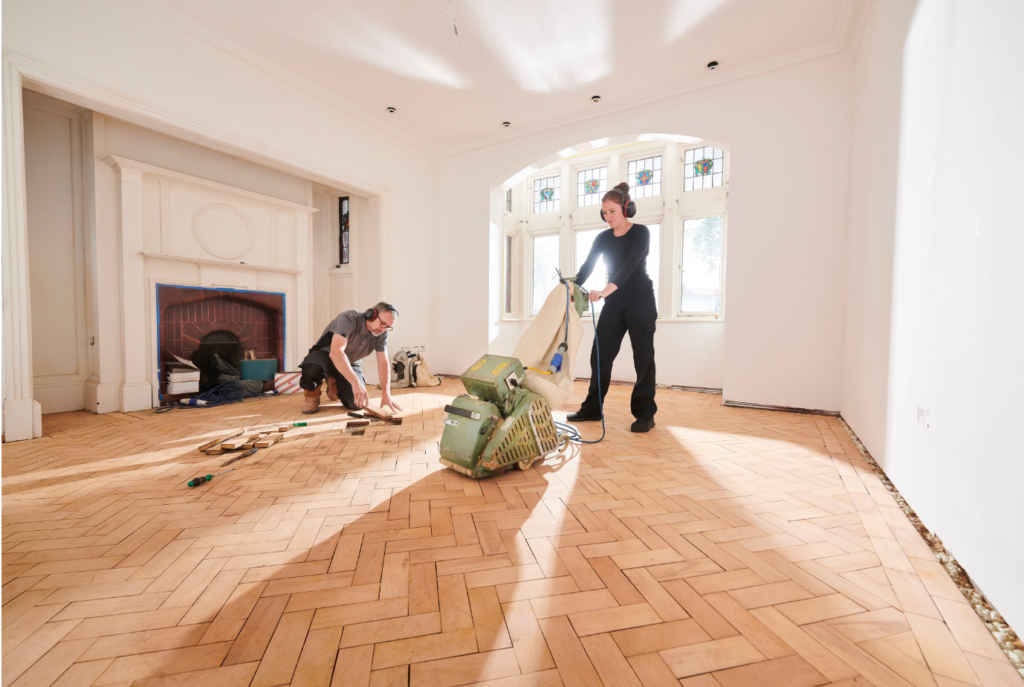In 2020, First Street Foundation assessed that over 14 million properties in the United States are located within the 100-year flood zone. With flood insurance claims that have totaled about $70 Billion since the 1970s, it’s safe to say that buying a house that is damaged by or at risk of flooding can be costly and not very APPEALING to homebuyers.

Flooding at home can be caused by atmospheric factors (i.e., hurricanes) and artificial factors (i.e., damaged plumbing system). Whether heavy rains or burst pipes caused water damage to your home, it’s important to tend to your property immediately after the flood to avoid further value reduction.
So here’s what you can do to sell your flood-damaged home in Georgia:
Restore Flooring (and Carpets)
When hardwood floors are soaked, they absorb water and tend to warp and discolor. As with water-soaked carpets, since they also don’t air dry as fast, they can promote mold growth more quickly and invite other bugs inside your home.
After being drenched in water, some carpets can still be dried without the need to take them out of the floor. You can brush the carpet first with a carpet cleaning solution, then suck all the water out with a wet vacuum. The next step is to blow dry the rug and expose it to a dehumidifier to remove the moisture. Note that drying a carpet may take days, so you may need to allocate time for this.
When the flooring and carpets are too damaged to simply dry, you’ll need to take them out and replace them with new ones. To do this, it’s best to contact professionals, especially if you see molds already.

Dehumidify Your Home
Dehumidify means to take the moisture out from the air and surfaces. You probably know that some materials don’t dry as fast as others; if this moisture stays long and mixes with heat, it creates a warm environment suitable for some unwanted organisms to grow. So if you weren’t able to dehumidify your home after the flood, it would be best to start now before you welcome any prospective buyers.
Eliminate Mold
Mold can severely affect our respiratory health. Damp surfaces are breeding grounds for mold, which develops commonly after a flood. When mold starts to colonize your walls, floors, ceilings, carpet, or furniture, it may be difficult to stop them from spreading quickly. While there are household items that can help you take the mold out on your own, we highly advise you to contact professional mold remediation services, especially when it has spread to significant portions. Specialists will have the right tools to contain the mold when they take them out and will ensure that mold spores will no longer spread into the air.
Take Out the Furniture
Flood can carry dirt, debris, toxic substances, microbes, and other materials that are harmful to our health. If your furniture were drenched in floodwater, especially sofas, beds, and other mattresses, it would be best to take them out. Mattresses can absorb the floodwater along with all its contents, and you wouldn’t want your buyer realizing they’re resting on a couch filled with potentially infectious diseases.
Recognize Flood Damages in Your Pricing
If you’re selling a flood-damaged home, you cannot price it on par with comps that are in good condition. You need a real estate agent with experience selling damaged properties to help you set the right price.
If you’re located in an area that’s at risk of flooding, then you’ll have to factor that in as well in your price. For water damages that are caused by plumbing problems, you don’t have to consider the home’s long-term exposure to floods because plumbing problems can be fixed immediately. Again, be realistic. Avoid pricing your property too high when it has flood damages.
Have Certifications on Hand
After certain repairs, you can request certificates from an inspector acknowledging that your flood-damaged property has undergone the right repair works and is fit/ready for inhabitation. This will give your prospective buyers peace of mind after knowing that the property has been exposed to flooding.
An example of a certificate you can present to your buyer is a Mold Remediation Report which can be provided by a licensed mold remediation specialist. This proves that mold has been completely removed from the house and that your buyers don’t have anything to worry about.
Sometimes, if the flood that your property was exposed to was a rare occurrence, you might want to show your buyer an FEMA Elevation Certificate. Again, this ensures they won’t have to worry so much about recurring floods.

Transfer Flood Insurance to the Buyer
In the United States, homeowners pay an average of $700 yearly for flood insurance. Needless to say, this isn’t very cheap, and not everyone can afford it. Additionally, flood insurance is typically not included in a homeowner’s insurance, so your buyer has to purchase one if your home really is within a flood-prone area — not quite appealing.
You have the option to transfer your flood insurance to them, though. Insurance companies allow this, but each may have different policies on how to go about this. Transferring your flood insurance isn’t a huge disadvantage. In fact, it may even add value to your sale since your prospective buyer won’t have to “start from scratch” to open a new insurance policy.
If you need professional help selling your flood-damaged home, our team at HomeSold GA can help you! We are familiar with the Georgia market, and we will help you find the right home buyer.
Call us at 770-668-4888.

